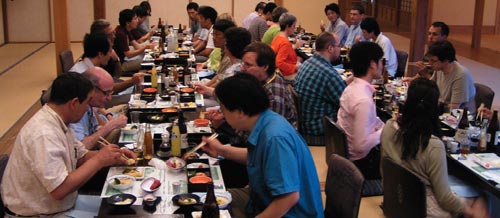Quark spin, gluon spin and the orbital angular momenta of quarks and gluons can all contribute to nucleon spin, but which has the main role? Physicists met in Tokyo to discuss.
Last summer, physicists from 10 countries came to the campus of the Tokyo Institute of Technology for the 5th Circum-Pan-Pacific Symposium on High Energy Spin Physics, held on 5-8 July 2005. The aim of this symposium is to enhance communications among physicists in the circum-pan-Pacific region as well as with guests from other regions, including Europe. Another feature is the active participation of young physicists.

In 1988, the European Muon Collaboration experiment at CERN reported that quark spin makes only a small contribution to the spin of the proton, contrary to what had been believed for many years. This gives rise to the well-known “nucleon spin problem”, now being studied by physicists all over the world: what in fact does give the proton and neutron their spin?
At the symposium, the COMPASS collaboration, EMC’s successor at CERN, reported on their measurements of the gluon spin’s contribution to the nucleon spin for which they use a high-energy muon beam together with the detection of “open charm” and hadron pairs. In addition to a longitudinally polarized deuteron target, COMPASS occasionally uses a transversely polarized deuteron target, and so can measure the Collins effect and hence the transversity distribution δq(x). δq(x), which is the distribution of transversely polarized quarks in a transversely polarized target, is the third distribution function at twist two, along with the momentum distribution q(x) and helicity distribution Δq(x).
At DESY, the HERMES experiment has performed quark flavour separation of helicity distributions Δq(x) using a ring-imaging Cherenkov detector for hadron identification. Further progress in this experiment has come with a transversely polarized hydrogen target, which has enabled the Collins and Sivers effects to be separately identified for the first time. Identifying each of these effects with both HERMES and COMPASS will also help in understanding the mechanism in hadron reactions, such as the sizeable single-spin asymmetries observed, for example, by the E704 experiment at Fermilab and STAR at the Relativistic Heavy Ion Collider (RHIC) at Brookhaven. A relationship between the Sivers effect and the orbital angular momenta of quarks has been suggested theoretically, and the quark orbital angular momentum could contribute to the nucleon spin.
RHIC uses polarized proton-proton collisions to study the nucleon-spin problem, and both the luminosity and beam polarization are becoming higher every year. Here each proton beam can be regarded as a bundle of high-energy partons, where gluon-gluon collisions and gluon-quark collisions tell us about the role of the gluon’s spin in the proton. The double-spin asymmetry ALL in π0 meson production has been measured with longitudinally polarized proton beams as a function of transverse momentum, pt, and transversely polarized proton beams are also used. At the symposium the PHENIX and STAR collaborations at RHIC presented recent data along with interesting plans for the future.
Jefferson Lab also has a variety of experiments to study the nucleon-spin problem. The symposium presented experiments on the quark helicity distribution at large x, deeply virtual Compton scattering, single-spin asymmetries from semi-inclusive hadron detection, investigations in the nucleon resonance region and quark-
hadron duality and so on, as well as the plan for a future beam-energy upgrade. High luminosity is one of the merits of Jefferson Lab.
The Belle collaboration at the KEK B-factory reported their analysis of the Collins fragmentation function in the hadronization process in positron-electron collisions, where a non-zero value for the function was observed. This fragmentation function is needed to extract the transversity distribution δq(x) from the Collins effect observed in lepton-nucleon scattering.
The symposium also presented plans for a neutrino-scattering experiment to study the spin of strange quarks in the nucleon. In addition, there were theory talks on nucleon-spin structure based on lattice quantum chromodynamic calculations, the chiral quark soliton model, di-quark model and resummation method etc. Here developments in generalized parton distributions were a main topic.
The symposium consisted completely of plenary sessions, so that all the participants could share the same discussions. On the afternoon of the second day, a boat trip was organized at Yokohama Bay, followed by a visit to a Japanese-style garden and a conference dinner in an old traditional Japanese house in the garden.








